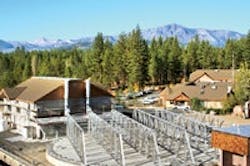About the author: Amy McIntosh is assistant editor for Water & Wastes Digest. McIntosh can be reached at [email protected] or 847.954.7966.
The South Tahoe Public Utility District’s (STPUD) wastewater treatment plant in South Lake Tahoe, Calif., serves approximately 26,000 full-time residents, but Lake Tahoe’s status as a recreational area can raise that number well above 100,000.
The district operates in the basin of Lake Tahoe, where effluent treatment is a priority. Despite regulatory pressures and a challenging effluent export configuration, the STPUD has operated without an effluent discharge violation since May 1995.
A Long History
In 1959, growing concern about effluent entering Lake Tahoe led the STPUD to upgrade its existing system of two redwood septic tanks to a regional wastewater treatment plant.
The plant underwent an upgrade in 1965, converting to a tertiary treatment process. To comply with the Porter-Cologne Water Quality Act—which stated that all wastewater and solid waste had to be removed from the Lake Tahoe watershed—the district began plans to build the export line over the mountain and into nearby Alpine County.
Because it was traveling to a reservoir with human contact, the effluent had to be treated to a third stage, making the STPUD plant one of the first full-scale tertiary treatment plants in the country.
“We actually had a map of the world in our board room and people would put a pin in it when they came from outside the country,” said Ross Johnson, plant operations manager. “We had dozens and dozens of pins. People from Russia and China and all over the world came to tour the plant.”
In the mid-1980s, the district began a new project using the plant’s effluent for irrigation. The plant was downgraded to an advanced secondary treatment process in 1989 and remains as such today.
The plant is 100% reuse, and the nutrient-rich water is exported to the Harvey Place reservoir and used by Alpine County ranchers to irrigate alfalfa fields.
The 7.7-million-gal-per-day plant has experienced a number of changes since then, which Johnson attributes to its location.
“Being in the lake basin and having to pump over the hill, our reliability needs to be extremely high,” Johnson said. “It’s caused us to do a lot of upgrades and improvements over the years.”
Currently, the plant has five force mains that pump to a new headworks building, which went online in the summer of 2012. Each of the force mains pumps to a mag meter for accurate flow measurement. From there, the water goes through Duperon screens with 1/4-in. openings, and then to a cyclonic grit removal process.
Next, the water enters two primary clarifiers, followed by complete mix-activated sludge and secondary clarifiers. Water then enters a ballast pump, followed by six multimedia pressure filters.
“We do something that is fairly unique and that is we have no digestion for flotation thickening or any type of sludge treatment prior to our centrifuges,” Johnson said. “We pull sludge directly off the bottom of our primary clarifiers and straight to our centrifuges with no other steps or storage in between.”
By collecting the sludge while it is still fresh, the plant retrieves sludge cake from the centrifuges that is 1% to 2% drier than usual.
The plant’s effluent is pumped to the Luther Pass Pump Station against a 265-ft head. From there, it is pumped over Luther Pass, against a 1,240-ft head, and then continues downhill to the Harvey Place Reservoir. According to Johnson, the export system alone costs the utility about $1 million a year in power.
Moving Forward
Johnson cites the O&M budget as the STPUD’s biggest issue. Due to economic constraints, the utility has cut its O&M budget by almost 20%.
“It’s the typical situation of being asked to do more with less,” Johnson said.
By optimizing the plant’s chemical feed disinfection process and employee scheduling, the utility hopes to get the budget back on track.
Additional challenges came with construction of the new headworks building.
The previous headworks, which was the original 1959 building, had been retrofitted once, but was quickly becoming obsolete.
“It wasn’t up to earthquake standards and it had a lot of problems, so we did an evaluation and decided that the best alternative would be to build a new facility,” Johnson said.
Completing the $8 million project came with its challenges, as the five force mains pumping to the existing headworks had to be transferred to the new facility. At night, during low flow periods, the crew had a four-hour window in which to disconnect pipes from the existing headworks and move them to the new building.
“It was not without its anxious moments, but we successfully completed that project this summer,” Johnson said.
Download: Here
